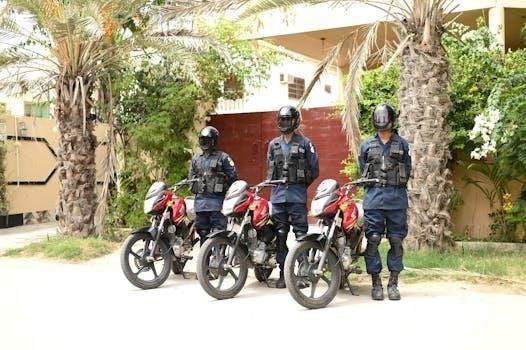Security Guard Responsibilities⁚ A Comprehensive Overview
Security guards shoulder vital responsibilities, extending beyond mere patrols. Their duties encompass risk prevention, emergency response, and public interaction, all integral to safeguarding people, businesses, and public offices. Vigilance, alertness, analytical abilities, and stamina are essential for performing these duties effectively and credibly.
Essential Daily Duties Checklist
A Security Guard Daily Duties Checklist is a vital tool, outlining essential tasks and responsibilities for each shift. It ensures guards fulfill their duties effectively, maintaining a safe and secure environment, and protecting premises and occupants. The checklist serves as a guide for comprehensive security coverage, enhancing safety and promoting a secure atmosphere.
The checklist typically includes items such as uniform and equipment checks to patrols and incident reporting, covering essentials for everyday security operations. Perfect for sites with standard security needs, it helps to manage tasks systematically, boost safety, and streamline communication. It should also include orientation, training, documentation, equipment allocation, and policy acknowledgment.
Essential duties covered range from identification checks and interactions with visitors to emergency response protocols. It’s imperative to establish patrol checklists clearly, including all aspects providing data of interest to the organization, specifying what needs checking, compliance criteria, and control frequency.
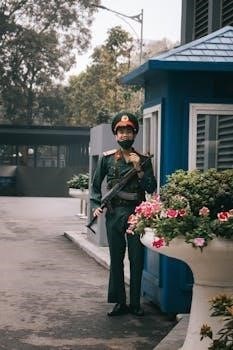
Following this essential guide ensures guards deliver stellar results and excel as credible security personnel. A supervisor’s signature confirms completion and accuracy, enhancing accountability and trust in security measures.
Patrol and Surveillance Responsibilities
Security guards undertake crucial patrol and surveillance duties to deter criminal activity and maintain a safe environment. These responsibilities involve regular patrols of the premises, monitoring for suspicious activities, and ensuring all areas are secure. Effective patrols require vigilance, alertness, and exceptional analytical abilities.
A Patrol Checklist is essential, ensuring all necessary tasks and areas are covered during routine patrols. This is particularly useful for guards monitoring large premises such as office buildings, warehouses, or residential complexes. The checklist allows for ensuring checkpoints are visited and patrols are conducted as planned.
Monitoring surveillance systems, including CCTV cameras, is a critical part of the role. Guards must be attentive to the surveillance feeds, identifying potential threats and responding appropriately. Observation and reporting are key components of effective surveillance.
Guards must accurately record and report any incidents or observations during their shift. Their role is integral to safeguarding property and personnel through proactive patrolling and diligent surveillance.
These duties are central to all types of security guard jobs, ensuring a secure environment for businesses and communities alike.
Access Control Procedures for Security Guards
Security guards play a vital role in access control, managing who enters a premises and ensuring only authorized individuals gain entry. This critical duty involves verifying identification, checking credentials, and maintaining a log of visitors. Effective access control is essential for preventing unauthorized access and maintaining a secure environment.
Guards must diligently check identification badges and ensure they are valid. They must also be adept at interacting with visitors, providing assistance while maintaining security protocols. Customer assistance is a key aspect of access control, balancing security with a welcoming demeanor.
The security guard is responsible for opening and securing gates, doors, and access points. Securing all doors, windows, and access points is an essential end-of-shift duty to ensure the premises remain secure overnight.
Access control also includes monitoring surveillance systems to detect and respond to any breaches in security. Guards must be vigilant and alert, ready to take immediate action if unauthorized access is attempted.
By diligently following access control procedures, security guards contribute significantly to the overall safety and security of the premises, protecting both occupants and assets. Thoroughness and attention to detail are crucial in performing these duties effectively.
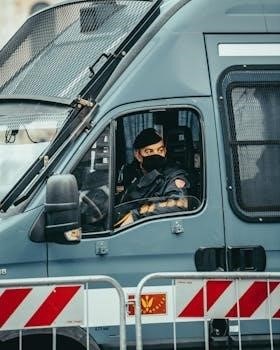
Emergency Response Protocols
Security guards are crucial in emergency response, acting as first responders to ensure the safety of individuals and property. Their duties encompass a range of critical actions, from assessing the situation to coordinating evacuations. Efficient and well-rehearsed emergency response protocols are vital for minimizing harm and maintaining order during crises.
Guards must be prepared to handle various emergencies, including medical incidents, fires, and security breaches. They need to be proficient in administering first aid, using fire extinguishers, and contacting emergency services. Quick and decisive action is essential in these situations.
In the event of an emergency, security guards are responsible for alerting the appropriate authorities and providing accurate information about the situation. They may also need to direct individuals to safety and maintain crowd control. Clear communication and leadership skills are critical during emergencies.
Regular drills and training are essential to ensure that security guards are familiar with emergency response protocols. They must know how to operate emergency equipment and follow established procedures. Continuous training enhances their preparedness and effectiveness.
By adhering to established emergency response protocols, security guards play a crucial role in protecting lives and minimizing damage during crises. Their ability to act quickly and decisively can make a significant difference in the outcome of an emergency.
Incident Reporting and Documentation
Comprehensive incident reporting and documentation are paramount responsibilities for security guards, ensuring accountability and providing valuable insights for future security measures. Accurate and detailed records of all incidents, observations, and activities are essential for maintaining a secure environment.
Security guards must meticulously document any unusual occurrences, security breaches, or safety hazards they encounter during their shifts. This includes recording the date, time, location, and individuals involved in each incident. Detailed descriptions of events and any actions taken are also crucial.
Incident reports serve as a valuable resource for analyzing security trends and identifying potential vulnerabilities. By tracking patterns of incidents, security personnel can develop strategies to prevent future occurrences and enhance overall security protocols. This proactive approach helps to minimize risks and improve safety.
Proper documentation also provides a clear audit trail for investigations and legal proceedings. Accurate and reliable records can be used to support claims, resolve disputes, and ensure compliance with regulations. This underscores the importance of thoroughness and accuracy in incident reporting.
Effective incident reporting and documentation require attention to detail, clear communication, and adherence to established procedures. Security guards must be trained to accurately record information and submit reports in a timely manner. This ensures that all incidents are properly addressed and documented.
Security Guard Equipment Checklist
A comprehensive security guard equipment checklist is crucial for ensuring that security personnel have the necessary tools and resources to perform their duties effectively. This checklist serves as a systematic way to verify the availability and functionality of essential equipment, promoting preparedness and enhancing security operations.
The checklist typically includes items such as an identification badge, which is essential for verifying the guard’s identity and authorization. A flashlight is vital for conducting patrols in low-light conditions, ensuring visibility and safety. A radio or communication device enables guards to stay in contact with supervisors and other team members, facilitating quick response to incidents.
Handcuffs may be included for situations requiring the restraint of individuals posing a threat. Other necessary items may include a first-aid kit for addressing minor injuries, a notepad and pen for documenting observations, and personal protective equipment such as a vest. Each item on the checklist should be inspected regularly to ensure it is in good working order.
Regular checks of equipment are essential for maintaining operational readiness. Batteries should be tested, radios should be tuned, and flashlights should be inspected for proper function. By verifying the condition of equipment, security guards can minimize the risk of malfunctions and ensure they are prepared to handle any situation.
The security guard equipment checklist should be reviewed and updated periodically to reflect changing needs and emerging technologies; This ensures that security personnel have access to the most effective tools available, enhancing their ability to protect people and property.
Maintaining Order During Events
Maintaining order during events is a critical responsibility for security guards, requiring them to manage crowds, prevent disruptions, and ensure the safety of attendees. Security personnel play a vital role in creating a secure and enjoyable environment for all participants.
One of the primary tasks of security guards during events is crowd management. This involves directing foot traffic, preventing bottlenecks, and ensuring that attendees can move safely and efficiently throughout the venue. Security guards may need to establish designated entry and exit points, set up barriers, and provide clear directions to attendees.
Security guards are also responsible for preventing disruptions and maintaining a peaceful atmosphere. This may involve monitoring attendee behavior, addressing complaints, and intervening in conflicts. Security guards must be prepared to handle situations such as intoxication, disorderly conduct, and unauthorized entry.
In addition to crowd management and disruption prevention, security guards play a key role in responding to emergencies. This may involve providing first aid, assisting with evacuations, and coordinating with emergency services. Security guards must be trained to handle a variety of emergency situations, including medical emergencies, fires, and security threats.
Effective communication is essential for maintaining order during events. Security guards must be able to communicate clearly and concisely with attendees, event staff, and emergency personnel. They should also be equipped with communication devices such as radios to stay in contact with other members of the security team.
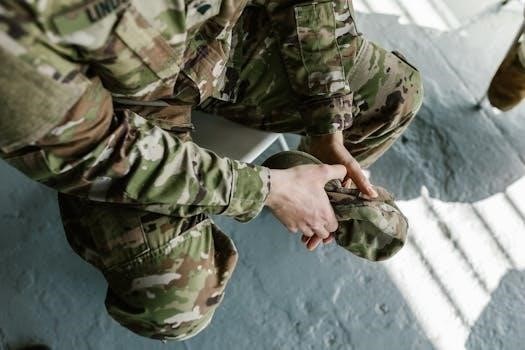
Security guards must remain vigilant and alert throughout the event, constantly monitoring the environment for potential problems. They should be prepared to adapt to changing circumstances and make quick decisions to ensure the safety of attendees.
Importance of Vigilance and Alertness
Vigilance and alertness are paramount qualities for security guards, forming the bedrock of effective security practices. A security guard’s ability to remain observant and attentive directly impacts their capacity to identify potential threats, respond swiftly to emergencies, and maintain a safe environment.
Vigilance involves a state of heightened awareness, where security guards actively monitor their surroundings, looking for anomalies or suspicious activities. This requires a proactive approach, where guards anticipate potential risks rather than simply reacting to incidents after they occur.
Alertness complements vigilance by ensuring that security guards are mentally and physically prepared to respond to any situation that may arise. This involves maintaining focus, avoiding distractions, and staying aware of changes in the environment.
The importance of vigilance and alertness cannot be overstated, as these qualities directly contribute to the prevention of crime and the protection of people and property. By remaining observant and attentive, security guards can detect potential threats before they escalate, allowing them to take appropriate action to mitigate risks.
In addition to preventing crime, vigilance and alertness are also crucial for responding effectively to emergencies. Security guards must be able to quickly assess the situation, make sound decisions, and take decisive action to protect lives and property.
To cultivate vigilance and alertness, security guards must receive proper training, maintain a healthy lifestyle, and practice mindfulness techniques. Regular breaks, adequate sleep, and a balanced diet can help guards stay focused and energized throughout their shifts.
The Role of Monitoring Surveillance Systems
Monitoring surveillance systems forms a crucial aspect of a security guard’s responsibilities, providing a virtual extension of their presence and enhancing overall security coverage. Security guards tasked with monitoring CCTV cameras and other surveillance equipment play a pivotal role in detecting suspicious activities, preventing crime, and responding effectively to emergencies.
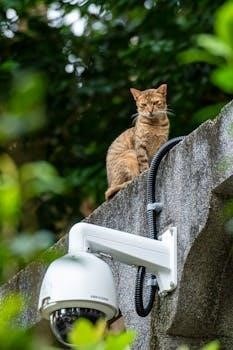
The primary objective of monitoring surveillance systems is to maintain a constant watch over designated areas, identifying potential threats and ensuring the safety and security of people and property. This requires a keen eye for detail, the ability to recognize patterns, and a thorough understanding of security protocols.
Security guards monitoring surveillance systems must be able to quickly assess situations, differentiate between normal and abnormal activities, and take appropriate action when necessary. This may involve dispatching security personnel to investigate, contacting law enforcement, or activating emergency response protocols.
In addition to detecting suspicious activities, surveillance systems can also be used to gather evidence, document incidents, and assist in investigations. Security guards must be trained to properly operate surveillance equipment, maintain accurate records, and preserve the integrity of evidence.
The effectiveness of monitoring surveillance systems depends on several factors, including the quality of the equipment, the positioning of cameras, and the training and alertness of security personnel. Regular maintenance and upgrades are essential to ensure that surveillance systems are functioning properly and providing optimal coverage.
Supervisor Verification and Accountability
Supervisor verification and accountability are paramount in ensuring the effectiveness and integrity of security guard operations. Supervisors play a critical role in overseeing security personnel, verifying their performance, and holding them accountable for their actions. This process ensures adherence to protocols, maintains high standards, and promotes a culture of responsibility.
Supervisor verification involves regularly checking security guards’ activities, ensuring they are fulfilling their assigned duties, and adhering to established procedures. This may include reviewing patrol logs, incident reports, and surveillance footage, as well as conducting on-site inspections. The supervisor’s signature on checklists confirms completion and accuracy.
Accountability is equally important. Security guards must be held responsible for their actions and decisions. This involves establishing clear expectations, providing adequate training, and implementing disciplinary measures when necessary. Regular performance evaluations can help identify areas for improvement and ensure that guards are meeting performance standards.
Effective supervisor verification and accountability mechanisms help prevent negligence, deter misconduct, and ensure that security guards are performing their duties diligently and professionally. They also provide a framework for addressing complaints, resolving disputes, and improving overall security operations.
Ultimately, supervisor verification and accountability are essential for building trust, maintaining order, and protecting people and property. By establishing clear lines of responsibility and implementing robust oversight processes, organizations can ensure that their security personnel are operating at their best and contributing to a safe and secure environment.
Onboarding and Training Checklists
Onboarding and training checklists are crucial for ensuring new security guards are adequately prepared to perform their duties effectively and professionally. These checklists provide a structured approach to orienting new hires, equipping them with the necessary knowledge and skills, and ensuring they understand their roles and responsibilities.
The onboarding checklist typically includes items such as orientation, training schedules, documentation requirements, equipment allocation, and policy acknowledgment. It ensures that new guards receive a comprehensive introduction to the company, its security protocols, and their specific job duties. This checklist helps to streamline the onboarding process and ensures that no critical steps are missed.
The training checklist, on the other hand, focuses on the specific skills and knowledge required for the job. This may include training on patrol techniques, access control procedures, emergency response protocols, incident reporting, and customer service skills. The training checklist ensures that new guards receive the necessary training to perform their duties safely and effectively.
By utilizing structured onboarding and training checklists, security companies and organizations can efficiently onboard new guards and ensure they are prepared to carry out their responsibilities with confidence. These checklists also help to improve employee retention, reduce liability, and enhance the overall quality of security services.
Furthermore, these checklists should be regularly reviewed and updated to reflect changes in security protocols, technology, and industry best practices. This ensures that security guards receive the most up-to-date training and are equipped to handle the evolving challenges of their roles.
Shift Details and End-of-Shift Duties
Understanding shift details and end-of-shift duties is paramount for security guards to ensure seamless transitions and maintain consistent security coverage. Shift details encompass the specific hours, location, and responsibilities assigned to a guard during their work period. This includes knowing the post orders, any specific areas of focus, and any special instructions for that particular shift.
End-of-shift duties are equally important, as they ensure that the next shift is properly informed and prepared. These duties typically involve a thorough handover process, which includes communicating any incidents, observations, or changes that occurred during the shift. Security guards must meticulously document all relevant information in the logbook or electronic reporting system.
A comprehensive end-of-shift checklist should include securing all doors, windows, and access points, ensuring that all equipment is accounted for and in working order, and reporting any maintenance issues or concerns. It’s also crucial to properly store any confidential information or sensitive materials.
Furthermore, end-of-shift duties may involve providing a verbal briefing to the incoming guard, highlighting any potential risks or areas requiring immediate attention; This ensures that the transition between shifts is smooth and that security coverage remains uninterrupted.
By adhering to a well-defined set of shift details and end-of-shift duties, security guards contribute to the overall effectiveness and reliability of the security operation. This promotes a safe and secure environment for all stakeholders.

